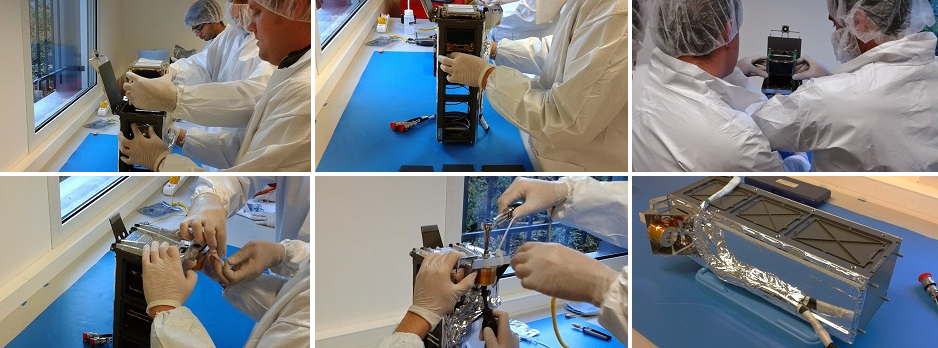It was a space project
10 years since the launch of PW-Sat
On 13 February 2012, the first Polish artificial satellite was launched from a space station in French Guiana. This historic project was developed at the Warsaw University of Technology – PW-Sat was created and built by our students.
It all started in 2004. A team from the Students’ Space Association, the pride of the Faculty of Power and Aeronautical Engineering, had been gaining experience through their participation in various space-related undertakings. Students saw that in other countries projects of student satellites were developed and they attempted to do the same in Poland, at WUT. They started talking, collecting people, analysing and in the end, thinking about the aim of the mission. They chose testing the deorbiting system, so removing the satellite from the orbit.
History
PW-Sat faced a few obstacles. The concept of the construction and the main goal of the undertaking changed, there weren’t enough people, time, motivation… There was support at difficult times, however. Significant help was offered by the European Space Agency (which organized a competition for student satellites to be put on the Vega rocket – PW-Sat took one of the places) and by the Centre for Space Research of the Polish Academy of Sciences (which shared their knowledge and provided students with a place to work).
According to the initial plan, the satellite was supposed to be completed in 2006. Young WUT constructors wanted to make each element on their own, from scratch, without using ready-made parts. They wanted to use a balloon for deorbiting, then a sail. Reality verified these ideas…
In autumn 2010, so after a few years of tests, uncertainty and gaining experience, students decided to buy some subsystems (a communication module, an antenna module, a power module and an on-board computer). They decided to concentrate on the new idea to complete the aim of the mission and on the body of the satellite and mechanical and electronic elements connected with the experiment. The work gained momentum. In 2011, after a few intensive months, PW-Sat was ready. Finally.
Mission
PW-Sat was built in the CubeSat standard, typical for student projects. This means, i.a., specific dimensions (shape of a cube of the dimensions 10 × 10 × 11.3 cm) and mass (no more than 1.33 kg, for PW-Sat it was 1 kg).
The WUT satellite was, first of all, to test the deorbiting system using a special structure, a so-called tail (the aim was to decrease the time spent by satellites on the orbit, so decrease the amount of space debris) and test the work of photovoltaic cells (increasing the efficiency, so increasing the possibilities of the satellite).
The tail had a spring shape of square cross-section and it was a metre long. PV cells were attached to the sides. For the launch, the whole structure was folded, it was inside the satellite. Only after a few weeks, on the order from the Earth, the tail was to open – a thread blocking the spring mechanism would be burnt and the tail would ”blow out” in a split second, still attached to the satellite on one end. With unfolded antennas and tail, PW-Sat had the dimensions of circa 150 x 100 x 13 cm.
What functioned during tests on the Earth did not work in space, however. While it was possible to get contact with PW-Sat (so it was possible to send information about the condition of the satellite), the main experiment with opening the tail failed. PW deorbited on 28 October 2014.
People
At its various stages, the project engaged several dozen WUT students. These were members of the Students’ Space Association, and then also of the Student Space Engineering Association. Many of them, still before the launch of PW-Sat, graduated, some of them were professionally connected with the space industry and then supported younger colleagues.
PW-Sat was primarily an educational project. It allowed participants to gain knowledge, skills and experiences. It also inspired another group of students to work on a new satellite – PW-Sat2. Its mission successfully ended in February 2021. Now work is being done on PW-Sat3. What started 20 years ago still brings fruit today.
***
At the last stage of work on the satellite, the greatest contribution to the project was made by: Kamil Bobrowski, Andrzej Cichocki, Marcin Dobrowolski, Rafał Graczyk, Jerzy Grygorczuk, Marcin Iwiński, Bartosz Kędziora, Adam Kostrzewa, Jan Kostrzewa, Andrzej Kotarba, Andrzej Kotarski, Michał Kurowski, Jakub Lisowski, Marta Mordalska, Piotr Orleański, Marcin Stolarski, Tomasz Szewczyk, Marta Tokarz, Maciej Urbanowicz (project head since 2010), Łukasz Wiśniewski, Piotr Wolański, Grzegorz Woźniak.
Earlier, on PW-Sat worked: Marcin Abramowicz, Kacper Bąk, Katarzyna Dąbrowska, Edyta Dziemińska, Wojciech Frączek, Szymon Fulara, Konrad Giec, Kamil Glebowicz, Arek Glinka, Jakub Głowacki, Paweł Grudziński, Krystian Górski, Tomasz Janson, Mariusz Kędzierawski, Paweł Kicman, Marcin Kocoń, Przemysław Kryczka, Michał Kurowski, Rafał Kwaśny, Krzysztof Mellem, Piotr Michniewski, Grzegorz Misiołek, Lukasz Mosdorf, Michał Mosdorf, Grzegorz Niemirowski, Marcin Nowakowski, Przemysław Nowakowski, Luis Daniel Ortiz-Kowalczuk, Inna Ouvarova, Jan Piekarski, Krzysztof Pięta, Mateusz Piwek, Rafał Przybyła (project coordinator in 2004-2009), Sebastian Rodak, Krzysztof Rogowski, Tomasz Rybarski, Tomasz Rybus, Tomasz Stanisławski, Artur Szybiak, Natalia Ustynowicz, Mateusz Wolski, Kamil Woźniak, Marian Zastawny, Mateusz Żmuda.









